Carlevaro Technique
Fijación Explained
UPDATED: Asunción, March 9, 2013; June 17, 2014; March 29, 2016
The more the player takes time to get acquainted with his playing apparatus, the more likely it is that he will figure out many nuances of guitar playing.
One concept that Maestro Abel Carlevaro describes very well in his book is the concept of Fijación literally, fixation. The concept implies the annulment of certain articulations in order to create larger muscle groups that will help you minimize string squeaks, produce a better more controlled sound in the right hand and will help you move more efficiently around the fingerboard with the left hand. This type of control over our playing apparatus is precisely what we need when we want to detach a note from the rest in either a chord or arpeggio. This is what we need when we have to repeat the same fingers pattern in a different position. Remember that when we we leave playing entirely to the fingers, we are heading towards fatigue; tension is just around the corner. This is where Fijación becomes so important. The word translated literally means Fixation. It consists of a technique that is sometimes applied involuntarily or intuitively if you prefer. Still, it is best to know and understand it thoroughly so as to use it as needed according to the specific right or left or both hands scenario that we may encounter. I consider fijación as one of the great breakthroughs of Carlevaro technique, not because he invented it but because he observed the phenomenon and explained it thoroughly.
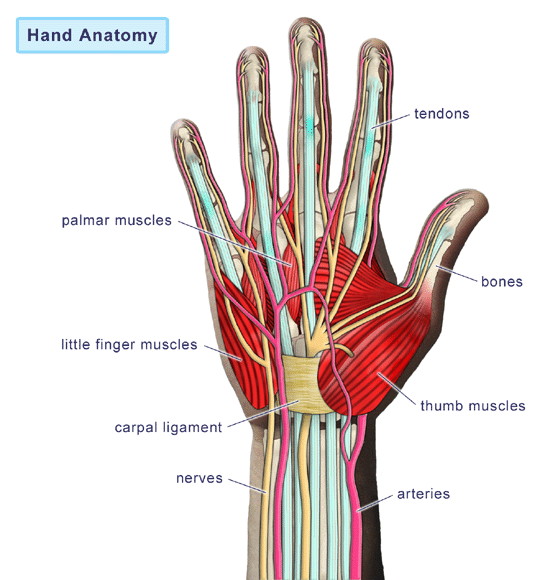
One great way to develop this concept is to apply it to our playing. In the example below, taken from Cavatina, you have a fantastic scenario to practice fijación in order to bring out the melody from an arpeggio.
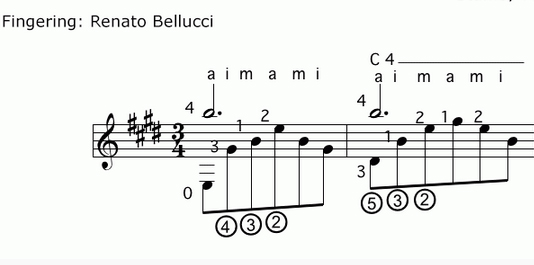
The challenge in Cavatina is to keep the melody in center stage and avoid using the rest stroke at all costs. The rest stroke ought to be used as a special effect and must not be abused or it will make our playing boring and flat. Apply Fijación to the a finger annulling its movable parts (the first and second phalanxes) which in turn will increase its mass (therefore its volume); i, m and a will then play the accompaniment with a normal free stroke. Fijación is a concept by which the player uses larger or smaller muscle groups to play a given note. It is the one technique that allows us to immobilize the left hand fingers in a manner that will allow us to lift them off the fingerboard in a more tidy way thus allowing us to avoid string squeaks altogether. Typically, when fingers are under a stretch, when they are lifted off teh fingerboard they will do so sideways and this will produce a squeak of teh string. Fijación will allow us to immobilize the finger and lift it perpendicularly using the most appropriate muscle for the task. Please refer to the video below to see exactly what I mean
Practice the arpeggio starting on the fourth position. What you do is move the arpeggio to the third, second first and back to the fourth position (or further if you like). The key again, is to do it flawlessly to acquire a perfect technique. This means play slowly at first watching and feeling every muscle movement until the proper moves are incorporated by your body and brain. Fijación must also be applied to the left hand in order to keep the curvature of the fingers of the left hand intact and avoid string squeaks when lifting the fingers off the fingerboard. This is, in Carlevaro's words, "Professional practice". Following are 3 great quotes by the Uruguayan master:
- "Selection of the right movements is the key to a perfect guitar technique".
- "Training of the fingers cannot be considered complete without the training of the hand, wrist and arm".
- "Genuine study takes place during short intervals and in moments of great mental concentration".
Below you can appreciate FIJACIÓN when applied to the left hand. The fingers of the left hand are kept stiff thanks to Fijación and the arm takes them from one position to the next on the fingerboard.
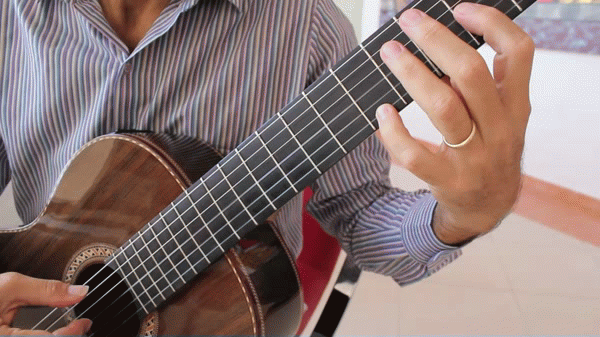
Below is staff #9 from Turkish March. I invite you to work this amazing piece following the link here →

About Playing Relaxed
A certain number of muscles will be working whenever the player is practicing or performing. The professional player though, must learn to master the use of the muscles necessary to perform a given work and only those muscles. Doing otherwise, will translate in muscular fatigue which, in turn, translates in poor sound and/or poor performance. When finger a for instance is not required to play a note, it must rest in a total or partial state of relaxation. Naturally, there are several degrees of muscular tension and relaxation ranging from low, to high. During tremolo for instance, the player can only partially relax the fingers between strokes.
Quoting Carlevaro:
"The isolated work of the fingers is the main cause of muscular fatigue"
Naturally, some people are built stronger than other. Therefore, how much muscle use is tension is a very personal matter.
I will start posting a series of "very down to the point exercises" for both hands. In the many years I have been playing, I only kept an exercise routine (I hate the word) for about 5 months. Exercises are only necessary to acquire a given skill. Once the skill has been learned, drop the exercise. This exercise is designed to acquire the following skills:
- Independence of the right hand fingers.
- Move the accent to any right hand finger.
- Change position on the fingerboard without producing undesired noises.
- Learn how to present the fingers in position B* on the fingerboard.
- Put to use the concept of fijación.
The Thumb Part 1
Of all the fingers, the one that creates an amazing stereophony is the thumb.
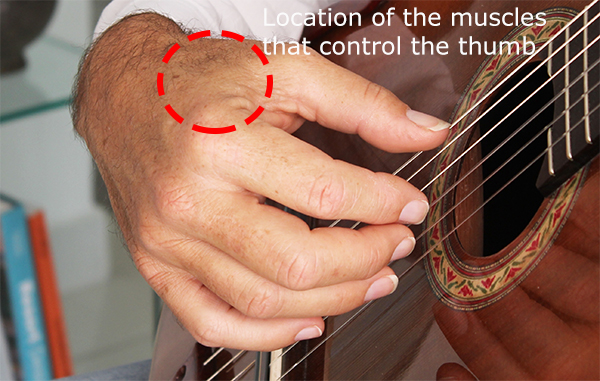
The thumb is the only finger with, supposedly, 2 phalanxes. That is because we often do not realize that the thumb moves from a place which seems to belong more to the hand than to the finger (pictures above). The size of the muscle that activates the thumb is simply huge in comparison with the muscles of the other fingers. The correct use of this muscle and its tendon will allow the thumb to create many different sounds. I normally use 3 (pictures below) but I can easily produce a 4th sound which I use very rarely.
Left Hand Thumb
The left hand thumb will mostly serve as a contact point to achieve opposition (see the anatomy pages). Its role is a passive one and it must never come in the way of the other fingers which will do the work. Depending on the degree of participation of the thumb, its use will go from totally liberated from the neck to directly opposing the fingers as in the case of barres that involve all the fingers. An example of a free thumb is vibrato and fast/very fast scales. The position of the thumb with regards to the other fingers changes also. When the left hand is playing musical passages that require little or no left hand position changes, the thumb will most certainly be located somewhere between the the fingers 1 and 3. When the musical situation implies position changes as in scales, the thumb will be displaced beyond finger 1 for leftward position changes and closer to finger 3 for rightward position changes. Keep in mind though that especially during scales the thumb must be extremely light or null on the neck to avoid tension and enable speed when necessary.
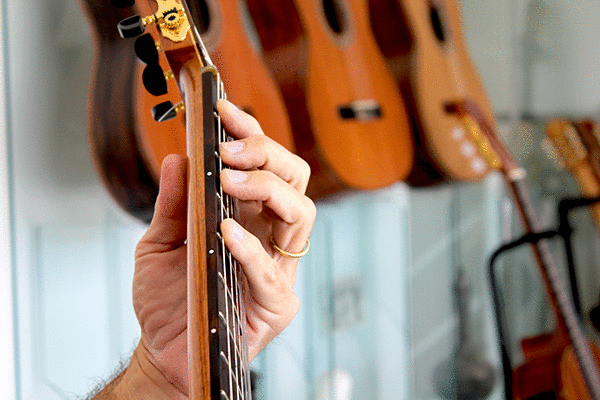
One great way to determine how much pressure or energy is really necessary to play a note or series of notes is to think the following: It is better not to have a left hand thumb than overusing the one we have. I learned to apply the following technique. Play a piece throughout without using the thumb. At least try to play a section without any help from the thumb. The first thing you will notice is that you can play without a left thumb. In this stage of practice you must forget tempo and think in terms of the most useful muscles for the job. After you have decided what is the best way to play a musical phrase without the thumb, get the thumb involved a little at a time until you feel you reached a healthy balance.
The one muscle that will eventually handicap your playing the most will be the muscle located between your thumb and finger 1. It is the one that brings most tension along.
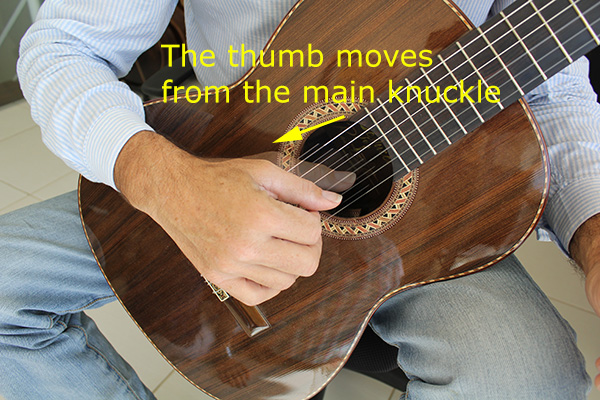
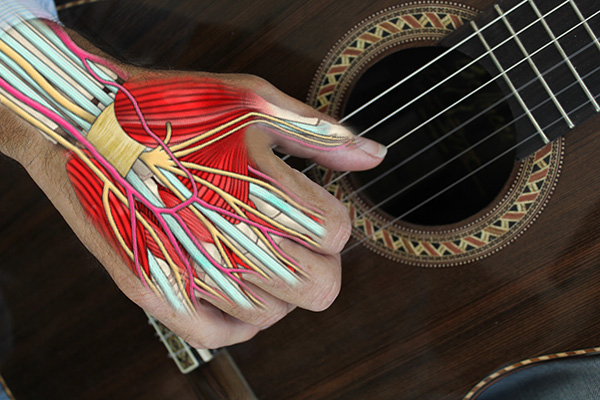
The pictures above show how I have come around the sound issue concerning the thumb. The first picture is what I call my base position. I build my playing around the sound produced by this position. The following picture shows my fast thumb position. The wrist is lightly more arched, therefore the tendons are tighter, the nail makes a smaller contact with the string. These two factors combined allow for higher speed.
This is my special thumb 1 which I use to produce a heavy sound in certain passages. Note that the nail attacks the string from above in a knife-like manner. I create an upward curvature with the finger (black arrow). The angle between the thumb and the index finger is slightly larger than it is in the previous position.
The things I notice after trying the 3 positions are: In position 1, the thumb gets in the way of the index finger. The sound I produce is very sweet though, therefore, I might consider this approach for slow, lute type of renaissance pieces.
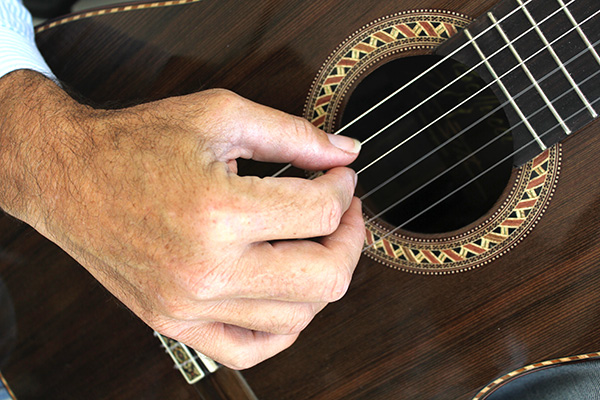
In position 2, which is my "standard position", I produce a "round" sound and there is no interference between the thumb and the other fingers. I use this position for most Baroque music, Preludes and Bourres and finally.
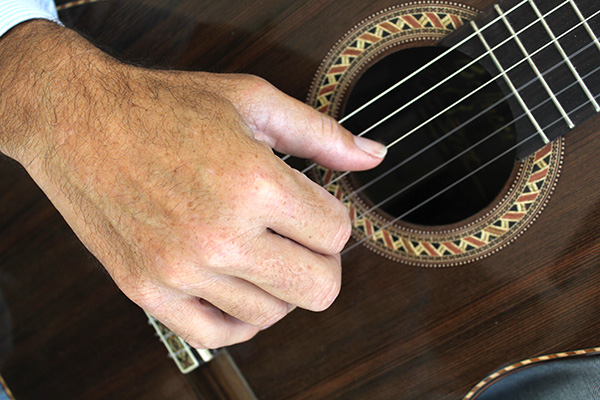
Below is what the above right hand position looks like from the players point of view:
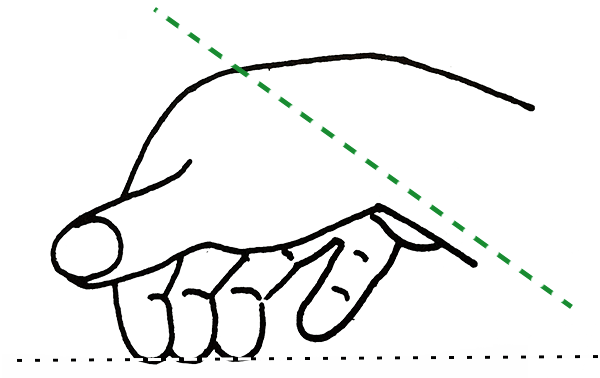
Position 3, which keeps the tendons in the right hand tighter which makes for the necessary speed in Spanish and South American music.
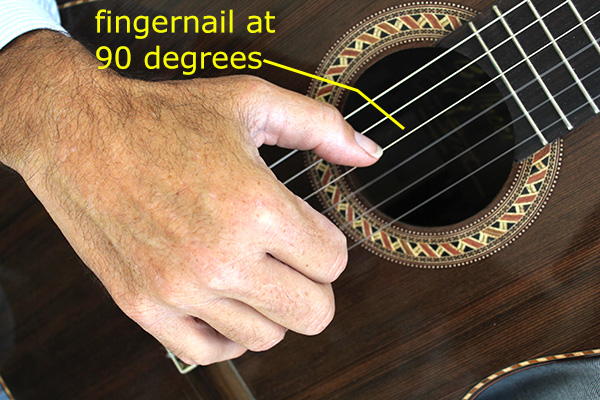
As you can probably imagine there is a lot of flexibility among these 3 thumb position and the change between them is always done very smoothly.
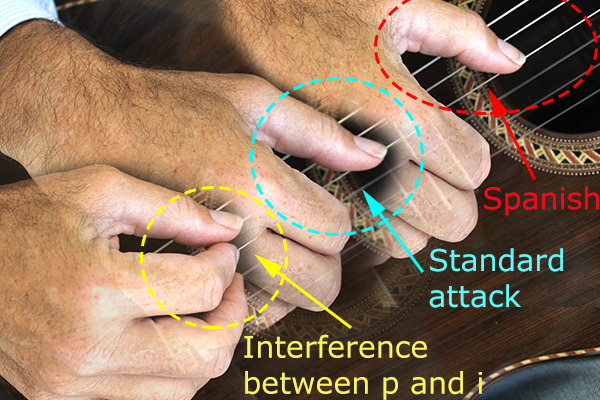
You can also use a pure flesh stroke for those pieces where a contrasting counterpoint is simply irresistible. All these strokes are not clear cut sounds. There are different degrees for each one of them and it is a very personal musical decision to use one or a combination of more than one.
The continuation of this class is in the members area, become a member today.
 Back to Top
Back to Top
